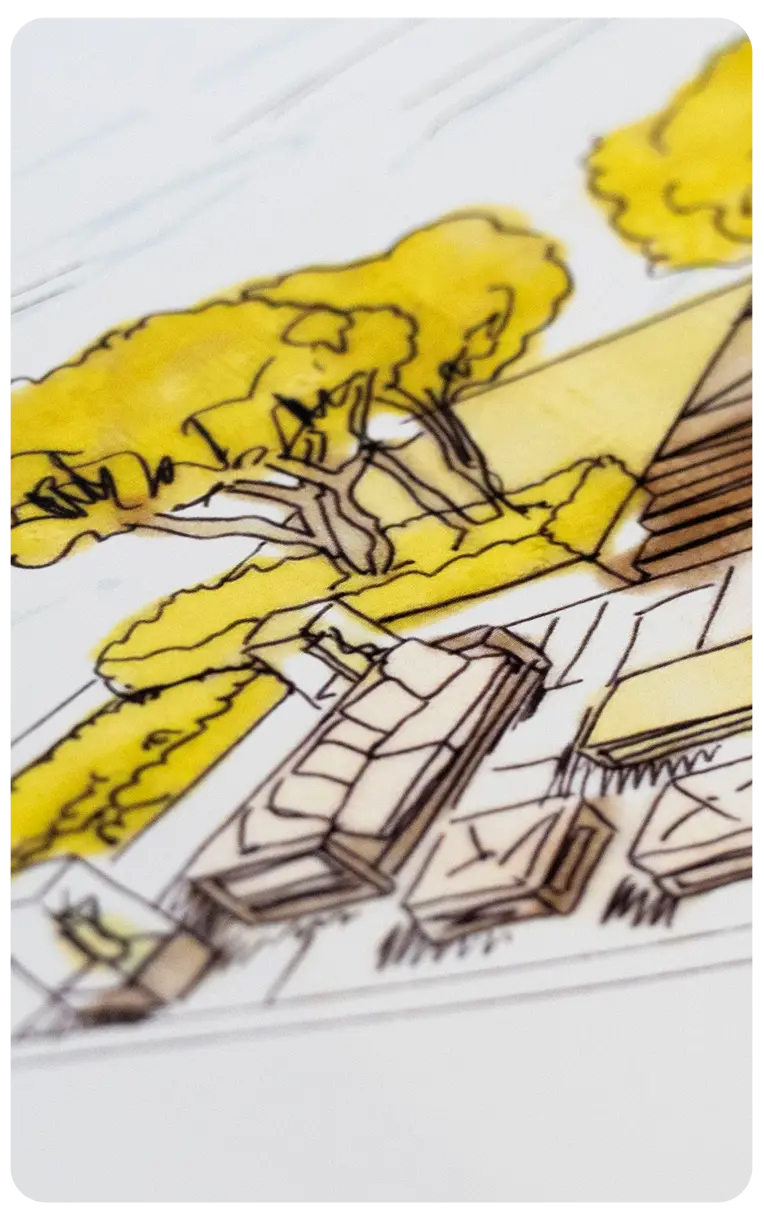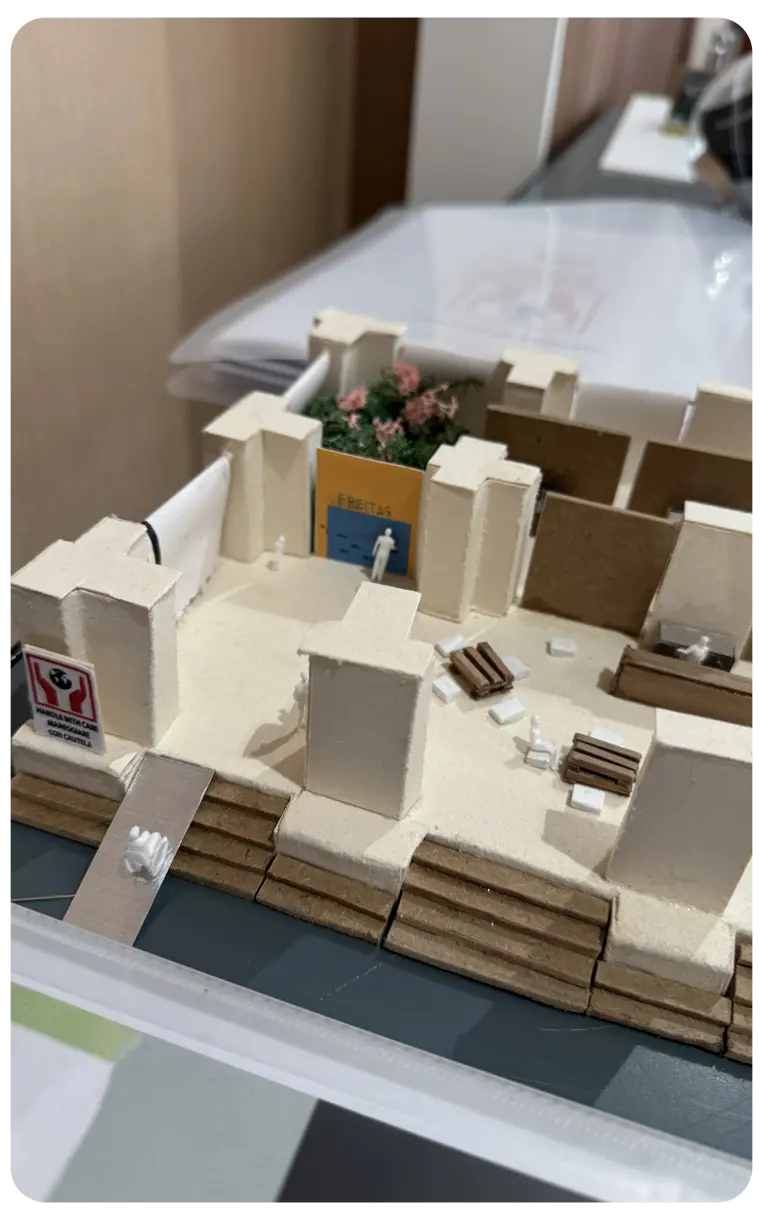BACHELOR'S DEGREE
Interior Design
Attendance
Duration
Language
Locations
Start date
Enrolment
Class size
Tuition fees
Non-EU citizens: €21.350
Course objectives
Interior Design
The objective of the 3-year degree course in Interior Design for Fashion is to provide students with the necessary skills to develop an interior design project for fashion in its various phases: from concept definition to project development.
The skills to be acquired by the end of the course are related to: understanding the needs and attitudes of users, as well as the social, cultural and psychological aspects that determine the way in which spaces for fashion are used; defining new design solutions in relation to the different ways in which environments are used by users; being able to understand the relationship between the design of interior spaces and the extension of services that can be provided within the interior design sector for the sale of fashion goods and services.
Qualification
Bachelor’s degree (accredited), awarding 180 credits (ECTS)
Entry Requirements
- Secondary school (high school) diploma or equivalent
- Suitable language level
Please see How to apply for information on admissions procedures



Teaching Method
At Accademia del Lusso you will be taught by working professionals from the fashion and luxury sectors who have a wealth of knowledge and experience.
The 3-year Bachelor’s degree course in Interior Design for Fashion contains a mixture of different teaching and learning techniques to develop a varied skill set and ensure a dynamic learning experience.
Lectures are combined with workshops and project work both in and out of the school, and field trips to companies, fashion events, trade fairs, and important fashion locations will take place throughout the three years of the course.
Classroom Lessons
External Visits
Seminars
Work Week and Workshops
Study Plan
- First Year
-
- Architectural Design of Style and Furnishing
Sector Code:ABPR15 - CFA:10 - Graphic techniques: two-dimensional analog representation in black and white and in color, freehand and through formal and summary representations. Expressive methods of the designer and use of graphic standards in technical drawing. Drawing as a project space to be constructed graphically.
- Representation of Architecture
Sector Code:ABPR15 - CFA:10 - Understanding the main tools and methods of representation for studying formal reality, in both drawing and modeling. Practice in the most suitable methods and techniques in relation to the content of the representation and the student’s inclinations. Digital drawing and modeling.
- Model Making
Sector Code:ABPR21 - CFA:8 - Providing the means to assess which type of material, technique, and finish are best suited for representing a product. Creating a model capable of reproducing the desired results based on its purpose. Analysis of volume, finish, and ergonomics fields.
- Material Typology
Sector Code:ABPR30 - CFA:4 - In-depth study of different types of materials used in interior design for fashion, their distinguishing qualities, and their requirements. Techniques for their transformation. Developing critical analysis tools to ensure each project uses materials that meet certain economic constraints and have a low environmental impact.
- History of Architecture and Urban Planning
Sector Code:ABST50 - CFA:4 - Deepening knowledge of architecture and urban planning in relation to the history, society, and culture that produced them. The focus is on studying architectural works related to the field of fashion.
- Design 1
Sector Code:ABPR17 - CFA:12 - Studying the concept and function of design within a design process, and learning a methodological approach related to material, geometric, formal, chromatic, and synesthetic elements that expand the design grammar. Learning methods to manage all design phases related to luxury residential interiors.
- Fundamentals of Computer Science
Sector Code:ABTEC39 - CFA:6 - Understanding basic principles and interacting with computer systems within the interior designer’s profession for fashion. Basic concepts of information representation and processing. Features of computer systems and the fundamental concepts behind PCs.
- Language 1
Sector Code:ABLIN71 - CFA:6 - English language and review of grammar rules. Written exercises, tests, conversations, dialogues, and readings related to the world of fashion.
- Architectural Design of Style and Furnishing
- Second Year
-
- History of Design
Sector Code:ABST48 - CFA:4 - The module aims to provide students with the necessary knowledge to understand and analyze the evolution of interior design, with a particular focus on the fashion field. The course includes the study of design through the evolution of its language, exploring iconic elements and examples of fashion interiors and a hybridization of their history within the visual arts.
- Design 2
Sector Code:ABPR17 - CFA:12 - Providing a method for analyzing issues and using data as design tools, leading to the development of a concept applicable to interior design for fashion in its broadest sense. Identifying luxury brands, analyzing them, and developing projects aimed at the point of sale, understood not only in a physical sense but also virtually.
- Ecodesign
Sector Code:ABPR17 - CFA:8 - A sustainable approach to interior design for fashion. A design process based on efficient use of resources and materials to reduce environmental impact related to production, and to minimize waste by focusing on durability, reparability, upgradability, and recyclability. Specific knowledge of various themes within the contemporary landscape of ecology applied to fashion interior design.
- Graphic Design
Sector Code:ABPR19 - CFA:4 - Basic knowledge of concepts such as brand, logotype, coordinated image, and other elements useful for creating graphic design artifacts and their derivatives for building brand identity. Information Architecture, an interdisciplinary field between design, computer science, graphics, and publishing. Techniques for developing communication artifacts for design projects, with particular attention to the third dimension.
- Photography
Sector Code:ABPR31 - CFA:4 - Basic knowledge of the history of photography and related fundamental photographic techniques. Correct and conscious use of the camera. Photographic language and analytical skills in studying and interpreting images.
- Digital Modeling Techniques – 3D Computer
Sector Code:ABTEC41 - CFA:8 - Theoretical and practical tools for understanding the process of defining a three-dimensional form in a virtual space generated by computer, useful for creating 3D models that graphically represent fashion interior design projects in a virtual environment. Includes rendering and postproduction for creating images that communicate the project.
- 3D Rendering
Sector Code:ABTEC41 - CFA:4 - Digital representation of the project starting from a 3D model. Basic knowledge of material assignment and mapping practices, creation and management of light sources for rasterizing frames that aid in understanding the designed and modeled space. Producing digital images that, through proper postproduction, define the digital design representation for project communication. Video production is a secondary objective of the course.
- Product Design
Sector Code:ABPR17 - CFA:10 - Provides the necessary knowledge of the technical issues involved in furniture object production. The course focuses on the creative and experimental aspects of the design process, with an approach geared toward real market needs.
- English 2
Sector Code:ABLIN71 - CFA:6 - English language and review of grammar rules. Written exercises, tests, conversations, dialogues. Readings related to the world of Interior Design.
- History of Design
- Third Year
-
- Design 3
Sector Code:ABPR17 - CFA:12 - Experimenting with fashion interior design and virtuality. Through the analysis of existing virtual retail spaces, ideation strategies will be identified for the development of an innovative project accessible via Virtual Reality, focused on innovative retail environments.
- Elements of Editorial Graphics
Sector Code:ABPR19 - CFA:6 - Theoretical and technical skills for designing a digital portfolio using image editing software. Analysis of layout, typography, and images.
- Design Management
Sector Code:ABLE69 - CFA:4 - Provides skills, methods, and tools for scenario and market analysis, evaluation of innovative projects and investments, strategic planning, and management of innovative product and service design. Analysis of the communication process in fashion design and its objectives.
- Light Design
Sector Code:ABPR18 - CFA:6 - Illustrates the main methods for designing and enhancing interior environments in the fashion sector through lighting, aiming to equip students with the conceptual tools necessary for critically selecting lighting methods and their components, across the range of lighting possibilities offered by natural environments, architecture, and the market.
- Exhibition Design
Sector Code:ABVPA64 - CFA:4 - The course aims to provide basic knowledge in the field of exhibit design, analyzing methodological, technical, and cultural aspects of fashion-related exhibition design. Students will deepen their understanding of the various tools used to create exhibition spaces and will acquire the skills necessary to solve spatial, functional, and aesthetic problems.
- English 3
Sector Code:ABLIN71 - CFA:6 - Elective Credits from Optional Courses, Labs, and Work Week
CFA:10 - Final Exam
CFA:6
- Design 3
Careers
This Bachelor’s degree course will shape students into professionals capable of analysing, processing and supervising the creation of a model, from the initial idea to its final realisation and distribution. The course provides professional skills that enable the student to design and follow a project in the world of fashion, based on knowledge of trends within the sector.
Work experience & internships
Our aim is to prepare students to enter the fashion world effectively and quickly. To this end, our Placement Service is constantly working to consolidate partnerships with the most prestigious fashion brands, the most original maisons, and the most innovative start-ups. We have built stable yet dynamic relationships that promote talent and our vision of sustainable innovation in fashion & luxury. The Careers Office is in contact with some of the best companies and agencies: this allows 90% of students to find important internships or professional collaborations within 6/8 months from the end of their course.

CAREER OPPORTUNITIES
What are the main career opportunities offered by the three-year degree in Interior Design?
-
01. Fashion Event Interior Designer - is the creative mind behind the design of spaces for fashion events, such as fashion shows, trade fairs, or presentations.
02. Fashion Store Designer- creates captivating layouts for fashion stores, ensuring the space reflects the brand and attracts customers.
-
03. Interior Stylist for Fashion Photography - collaborates with fashion photographers to create sets and environments for fashion photo shoots.
-
04. Visual Merchandiser - Works with visual merchandising teams to create installations and setups that enhance the display of products in store windows.